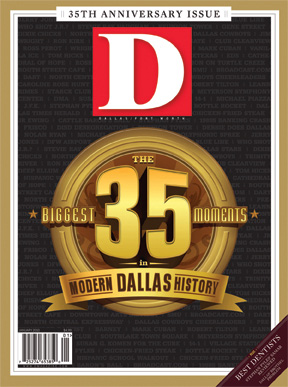If Electronic Data Systems had simply concerned itself with finding a new headquarters when the company began outgrowing its former homebase in the late 1970s, North Texas would look much different today. But because it took into account the fact that its move north into Plano might spur other companies to take a similar step, it made way for the explosive growth of Frisco, McKinney, Allen, and, of course, Plano over the last two decades, thanks to the relocations of corporations such as Frito-Lay and JCPenney. It all began in 1985, when EDS moved into the carefully planned Legacy development.
The relocation of Electronic Data Systems from Forest Lane to Plano in 1985 was initially driven by the company’s growth in the late 1970s and the corresponding need to attract and hire numerous highly skilled people. Our ability to expand the facilities at Forest Lane was limited, and with the majority of our employees living north of LBJ Freeway, we knew that attracting new talent there would also be challenging. So we started looking for a larger location closer to the talent pool at the time, and that led us to Plano.
At the same time, we realized a larger vision: that a location like Plano had the ability to attract other corporations like EDS to North Texas from around the country. So we expanded our objectives and searched for the location that eventually became the vast Legacy development in Plano.
Our move shifted into high gear after a comprehensive study confirmed that the majority of EDS’ employees lived in the northern suburbs and commuted via an overburdened Central Expressway and a Dallas North Tollway that ended at Belt Line Road, offering little help to our employees’ lengthy commutes.
We were also working through the challenges of obtaining zoning variances from Dallas due to various concerns from the surrounding neighborhoods regarding any expansion.
As we developed and refined the planning process, we began purchasing land in anticipation of the move. We searched for and found a person to manage the project for us: Robbie Robinson, a former Navy Seabee officer and an expert at massive projects like this. Robinson and his team carefully managed what was an enormous project on many levels to create one of the most impressive corporate office parks in the country and an exceptional EDS campus.
One of Robinson’s first objectives was to work with the Dallas neighborhood residents to address their concerns and issues, as well as ours, and reach an amicable scenario for us to leave the Forest Lane location. In 1982, for almost the entire year, Robinson and the team held 220 meetings with resident groups and individuals in the neighborhood, who were important constituents to us. In general terms these discussions resulted in retaining the commercial zoning while changing the remaining Forest Lane property to high-end residential zoning. This would provide a quality development while minimizing traffic issues. IT received strong support from the local community and passed the Dallas City Council unanimously.
EDS eventually assembled 2,665 acres (4 square miles) of real estate immediately south of State Highway 121, adjacent to the west side of Preston Road, and as far south as the future Spring Creek Parkway. With the support of the city of Plano, the planning team developed three zoning categories to provide the flexibility to attract a variety of businesses, retail and residential. The 300-acre center part of the site (roughly the same size as downtown Dallas between the freeways) was urban center zoning for high-rise offices, hotels, retail, and dense residential. The remainder of the site was divided between regional office and corporate campus zoning.
The regional office zoning allowed a range of site sizes for smaller corporate offices, office warehouses, and multifamily residential. The corporate campus zoning was designed for the large corporate sites such as the future EDS location. This allowed corporations and businesses flexibility to provide for their current needs and the ability to expand as they grew. It also allowed employees to live, work, and relax at a variety of restaurants and shops all within a reasonable walk. EDS opted for a 367-acre site in the middle of the development adjacent to the urban center.
Equally important to the development of the zoning were the utility, road network, and landscaping concepts. Companies demand reliable utilities, so all utilities would be underground and the most critical ones, such as electricity and communications, would be encased in concrete and redundant. Roads would handle rush-hour traffic volumes and have wide medians and setbacks to make the driving experience as pleasant as possible. The landscaping would be plentiful, attractive, and require minimal maintenance.
The development was named Legacy. One of the oldest cemeteries in North Texas is located in the center of the development. In addition, buffalo once roamed this high ground (the highest in Collin County), as did herds of cattle moving north on the Shawnee Trail. The name Legacy commemorates this heritage.
When it opened, Legacy offered a high-quality development, business-oriented zoning, reliable utilities, proximity to DFW airport and to Dallas, local government tax abatements, and the ability to attract and hire talented personnel. Corporations and businesses immediately started to relocate to Legacy. Frito-Lay’s headquarters was the first, followed by the move of JCPenney from New York City. A vibrant and attractive urban center was created, which is considered one of the more successful developments in the United States.
Meanwhile EDS, after an extensive selection process, chose an architect to design a complex of four data centers, a computer management center, three office buildings, and a headquarters building. These are of similar contemporary architecture to the Forest Lane site but on the inside were built to accommodate future technology. With the award of the General Motors data processing contract to EDS, four additional office/training buildings were built. The ability to expand rapidly to meet business needs was successful and is something that could not have happened at the Forest Lane location.
What is most important about Legacy is its positive impact on North Texas. It was, to a large extent, the economic engine for the North Dallas area. It initiated and has continued to help drive the explosive growth of Plano, Allen, Frisco, and McKinney. These cities have set national growth records and achieved average per capita income records, best place to live designations, All American City awards, best place to retire designations, reduced residential taxes, and more. It has also helped attract high-quality employees, significant retail, restaurants, and hotels. All this has greatly benefited the entire area.
Ross Perot is the founder of Electronic Data Systems and Perot Systems.







